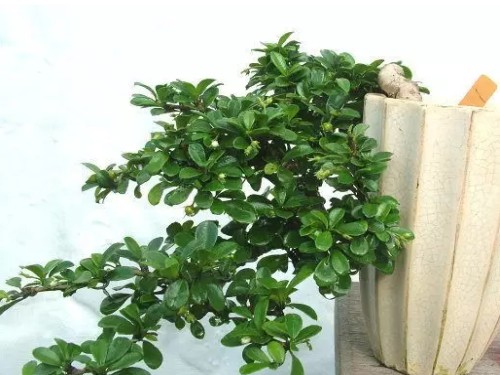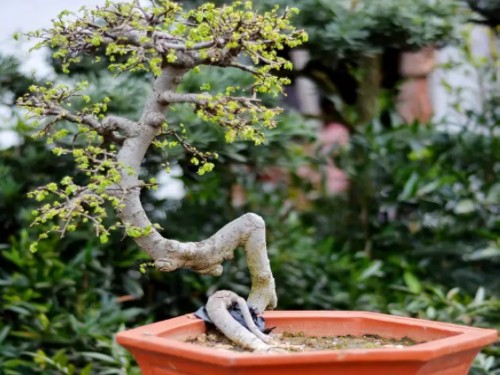Maintenance method of bonsai of Luohan pine
The bonsai trees of Luohan pine are lush and elegant, ancient and vigorous, with bright green leaves all the year round, with a sense of vitality and nobility. If attached to the rock, made into the posture of eagle claw holding stone, more quaint and chic. Luo Hansong and bamboo, stone group scenery, extremely elegant. Jungle-style Luohan pine bonsai, coupled with grazing scenery, can give people a wild enjoyment. If cultivated properly, it will become an excellent bonsai of Luohan pine after decades to a century of prosperity.
Pinus elliottii, a small evergreen tree of Pinaceae, is a variety that has been mutated by long-lasting potted plants. It is evergreen all the year round, and its needles are like real beads. Brilliant green, vigorous branches, long life, is commonly used in the production of bonsai tree species, the tree shape is exquisite, is the production of bonsai valuable tree species. Rice leaf Luohan pine prefers gentle and humid environment, is more shade-tolerant, and prefers sandy loam with fertile, loose, well-drained and slightly acidic soil. In view of these characteristics, it is not difficult for us to do a good job in the maintenance of rice leaf Luohan pine bonsai.

1. Soil
The culture soil can use 2 parts of forest rotten leaf soil, 2 parts of mountain soil, 2 parts of humus soil, 2 parts of pond soil, 2 parts of mature barnyard manure, fully mixed, exposed for several days, carefully sifted, and mixed with a small amount of culture soil with rotten oil withered powder and dried pig manure.
2. Lighting
Pinus elliottii is a neutral and negative tree species, which can accept strong light and grow in a shady environment. Although the temperature is high and the sun is strong in summer, it is not necessary to shade the tree in summer because the tree is propitious to maintain its leaf shape under the condition of high temperature and strong light. Because of the tender tissue, the seedlings of Luohan pine should not be exposed to strong light for a long time, so it is suggested that they should be preserved in the shade.
3. Temperature
Luohansong likes warmth and has weak cold resistance. When the winter temperature drops to 13 ℃, it goes into dormancy, and the lowest temperature should not be lower than 10 ℃.
4. Watering
Luohansong is resistant to Yin and dampness, so it should be watered frequently during the growing period, but it should not be watered. In summer, we should often spray foliar water to make the leaves bright green and grow well.
5. Fertilization
The formed bonsai should not be fertilized more, apply sparse cake fertilizer and water for 1 to 2 times in spring and stop fertilization in autumn to avoid sprouting autumn buds, which is disadvantageous to overwintering.
6. Pruning
Luohan pine can be pruned all the year round, mainly cutting off long branches and diseased branches to maintain a beautiful tree shape. When blooming, it is best to pick the buds in time, so as not to consume nutrients and affect the growth potential.
7. Turn the basin
The basin can be turned once every 2-3 years, and it is better to do it from March to April in spring. When turning the basin, replace the old soil with 1 hammer and 2 old soil, and cut off the withered roots to stretch out the fibrous roots. If the plant is enlarged, it can be replaced with a larger pot. In addition, it can also be combined with turning the basin, gradually lift the root, attached with rocks, and shape the root-type or stone-attached bonsai.
When turning the basin, replace the old soil with 1 hammer and 2 old soil, and cut off the withered roots to stretch out the fibrous roots. If the plant is enlarged, it can be replaced with a larger pot. In addition, it can also be combined with turning the basin, gradually lift the root, attached with rocks, and shape the root-type or stone-attached bonsai.
8. Diseases and insect pests
Common diseases are coal fouling disease and leaf spot disease. 0.5% Bordeaux solution can be used and sprayed once every 10 days for 3 consecutive times in the month before the plum rain season. The main pests are large coir moth, red wax shell insect, red spider and so on, which can be sprayed with dichlorvos 1200-1500 times or 40% dimethoate 1500 times.
9. Display
Luo Hansong verve tall and straight, elegant, horizontal space shows a simple, stable and vigorous arrogant momentum; tree-shaped show, like a tolerant host, waving his arms, smile to welcome guests, humbly send friends, with endless fairy rhyme in line with people's state of mind. So it is not suitable to put at home, put in the balcony should also have a broad area.
Time: 2019-06-01 Click:
- Prev

How to lose the leaves of Fujian teapot scenery?
Fujian tea, also known as base tree and cat tree, is an evergreen shrub of Arnebiaceae. The leaves are small, long oval, dark green and shiny. White florets bloom in spring and summer, drupe globose, red after green. With its rugged trunk, colorful Qiu qu and elegant posture, it is one of the four major bonsai tree species in Lingnan, and it is also five species exported to the United States after China's entry into WTO.
- Next

What if the elm leaves fall off?
The elm bonsai I bought a month ago was fine at first. After two days of cultivation, aphids began to grow and the leaves withered. Then I wrote on the Internet to remove all the leaves, and spray pepper water, and then improved, began to shoot new buds. But now somehow the leaves start falling again, no bugs this time.
Related
- Fuxing push coffee new agricultural production and marketing class: lack of small-scale processing plants
- Jujube rice field leisure farm deep ploughing Yilan for five years to create a space for organic food and play
- Nongyu Farm-A trial of organic papaya for brave women with advanced technology
- Four points for attention in the prevention and control of diseases and insect pests of edible fungi
- How to add nutrient solution to Edible Fungi
- Is there any good way to control edible fungus mites?
- Open Inoculation Technology of Edible Fungi
- Is there any clever way to use fertilizer for edible fungus in winter?
- What agents are used to kill the pathogens of edible fungi in the mushroom shed?
- Rapid drying of Edible Fungi

